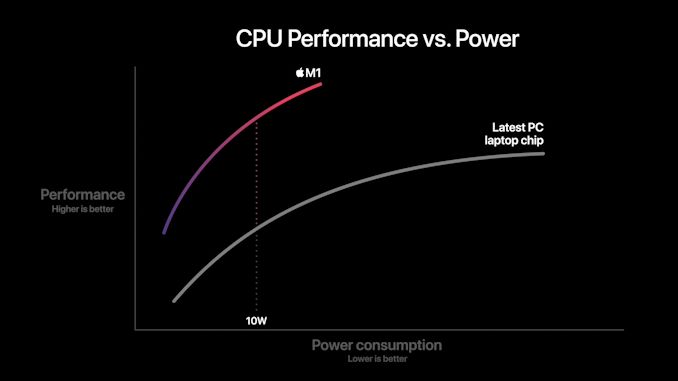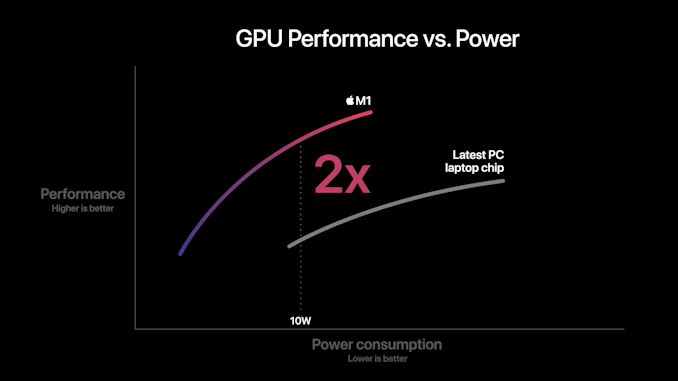Apple Announces The Apple Silicon M1: Ditching x86 - What to Expect, Based on A14
by Andrei Frumusanu on November 10, 2020 3:00 PM EST- Posted in
- Apple
- Apple A14
- Apple Silicon
- Apple M1
Apple Shooting for the Stars: x86 Incumbents Beware
The previous pages were written ahead of Apple officially announcing the new M1 chip. We already saw the A14 performing outstandingly and outperforming the best that Intel has to offer. The new M1 should perform notably above that.
We come back to a few of Apple’s slides during the presentations as to what to expect in terms of performance and efficiency. Particularly the performance/power curves are the most detail that Apple is sharing at this moment in time:
In this graphic, Apple showcases the new M1 chip featuring a CPU power consumption peak of around 18W. The competing PC laptop chip here is peaking at the 35-40W range so certainly these are not single-threaded performance figures, but rather whole-chip multi-threaded performance. We don’t know if this is comparing M1 to an AMD Renoir chip or an Intel ICL or TGL chip, but in both cases the same general verdict applies:
Apple’s usage of a significantly more advanced microarchitecture that offers significant IPC, enabling high performance at low core clocks, allows for significant power efficiency gains versus the incumbent x86 players. The graphic shows that at peak-to-peak, M1 offers around a 40% performance uplift compared to the existing competitive offering, all whilst doing it at 40% of the power consumption.
Apple’s comparison of random performance points is to be criticised, however the 10W measurement point where Apple claims 2.5x the performance does make some sense, as this is the nominal TDP of the chips used in the Intel-based MacBook Air. Again, it’s thanks to the power efficiency characteristics that Apple has been able to achieve in the mobile space that the M1 is promised to showcase such large gains – it certainly matches our A14 data.
Don't forget about the GPU
Today we mostly covered the CPU side of things as that’s where the unprecedented industry shift is happening. However, we shouldn’t forget about the GPU, as the new M1 represents Apple’s first-time introduction of their custom designs into the Mac space.
Apple’s performance and power efficiency claims here are really lacking context as we have no idea what their comparison point is. I won’t try to theorise here as there’s just too many variables at play, and we don’t know enough details.
What we do know is that in the mobile space, Apple is absolutely leading the pack in terms of performance and power efficiency. The last time we tested the A12Z the design was more than able to compete and beat integrated graphics designs. But since then we’ve seen more significant jumps from both AMD and Intel.
Performance Leadership?
Apple claims the M1 to be the fastest CPU in the world. Given our data on the A14, beating all of Intel’s designs, and just falling short of AMD’s newest Zen3 chips – a higher clocked Firestorm above 3GHz, the 50% larger L2 cache, and an unleashed TDP, we can certainly believe Apple and the M1 to be able to achieve that claim.
This moment has been brewing for years now, and the new Apple Silicon is both shocking, but also very much expected. In the coming weeks we’ll be trying to get our hands on the new hardware and verify Apple’s claims.
Intel has stagnated itself out of the market, and has lost a major customer today. AMD has shown lots of progress lately, however it’ll be incredibly hard to catch up to Apple’s power efficiency. If Apple’s performance trajectory continues at this pace, the x86 performance crown might never be regained.












644 Comments
View All Comments
rtharston - Thursday, November 12, 2020 - link
These benchmarks are all CPU only (with some memory bandwidth too, since the CPU can't do anything without memory...). All these figures are CPU only. Yes, Apple managed to make a CPU that is as fast or faster than Intel and AMD. Just read the article and you'll see how. They have more ALUs. They have more registers (thanks to ARM64). They have larger (and faster) caches across the board. All that adds up to a higher performance CPU.You are right about the dedicated silicon being better at other things though, so now imagine how much more performance Apple's devices will have when using these fast CPUs *and* the dedicated silicon to do other things.
daveedvdv - Thursday, November 12, 2020 - link
> My opinion is that using dedicated silicon for a specific task and not generic CPU computing is where almost ALL of the improved performance comes from.No. Neither SPEC nor GeekBench would take advantage of that.
Furthermore, the applications that Apple uses to boast about the CPU (not GPU) performance are thing like Clang, Ninja, and CMake, which wouldn't benefit from that either.
millfi - Wednesday, June 23, 2021 - link
Dedicated silicon is very fast and efficient when run specific Tasks with a high degree of parallelism, such as ML. But this cannot explain that M1 chips high IPC recorded in spec int. Because this benchmark runs general tasks which are written general CPU Instructions. If Apple could offload such a task to a dedicated circuit, that would be magic.melgross - Wednesday, November 11, 2020 - link
The M1 isn’t that much of an advance.BlackHat - Tuesday, November 10, 2020 - link
Guys, the main reason why I loved your website is because you dig in marketing footnotes, I don't know if you already read it (Aparrently no) but they are out and Apple claims that "the most powerful chip or the most power-efficient" is against their own 2018 MacBook, an 14nm i7 SkyLake with LPDDR3, no even against their last Ice Lake model, let alone Renoir (yes I know Apple doesn't have ryzen products) I don't know know if I missing something but I think that you ARM destroying x86 isn't going too far? Yes is power efficiency but it is that big difference to ignore all the performance lost?Greetings.
BlackHat - Tuesday, November 10, 2020 - link
And the single core claims are based in single core peak performance in "leadership industry benchmarks" whatever that means and an combination of JavaScript test and Speedometer (this last one I heard from you that was close to Apple) so, anyways we will wait for bench.Kilnk - Tuesday, November 10, 2020 - link
https://browser.geekbench.com/processor-benchmarkshttps://browser.geekbench.com/ios-benchmarks#
https://www.cpu-monkey.com/en/compare_cpu-apple_a1...
These are the benchmarks they are talking about.
Single core is faster than anything else in the consumer market. Yes. ANYTHING else.
Multicore lands just above the 9700KF.
BlackHat - Tuesday, November 10, 2020 - link
The think why people don't thrust Geekbench is because even they confirmed that old Geekbench benchmarks (basically 4 and older) were inaccurate due its dependency of bigger caches, meaning that CPU with bigger caches could beat other CPUs in short workloads (something that Geekbench those) but I can be wrong.name99 - Tuesday, November 10, 2020 - link
You mean Apple "cheat" by adding to their CPUs the pieces that make CPU's run faster, like a larger cache?OMG, say it isn't so!
The pretzels people twist themselves into when they don't want to face reality...
Just as a guide to the future, look to what really impresses those "skilled in the art" about this CPU. It's explicitly NOT the cache sizes; those are nice but even more impressive are the LSQ sizes, the MLP numbers (not covered here but in an earlier AnandTech piece) and the spec numbers for mcf and omnetpp.
Understand what those numbers mean and why they are impressive and you'll be competent to judge future CPUs.
BlackHat - Tuesday, November 10, 2020 - link
Talking about twist and you twist my comment, what Geekbench maker themselves said is due their bechmarks being of short run, CPUs with big caches show a big margin (no matter if Apple or other maker, in fact, they show how Samsung Exynos mongoose took advantage of this), for long workload the benchmark was useless.